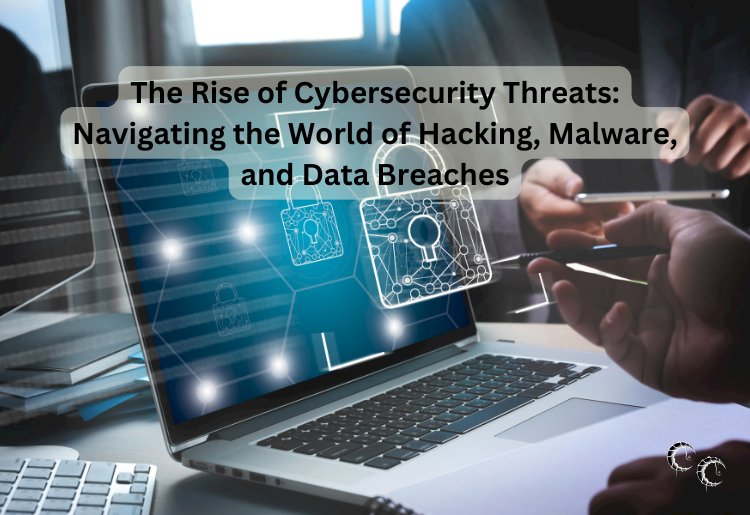The Rise of Cybersecurity Threats: Navigating the World of Hacking, Malware, and Data Breaches

In today’s increasingly digital world, cybersecurity has become one of the most critical concerns for individuals, businesses, and governments alike. With more of our personal, financial, and professional lives taking place online, the threat of cyberattacks is more pervasive than ever. From hackers infiltrating networks to malware infecting devices, the risks to our sensitive information are constant and evolving.
As we continue to integrate technology into every facet of life, it’s essential to understand the rising tide of cybersecurity threats and how we can better navigate and protect ourselves in this dangerous digital landscape.
The Growing Threat Landscape
Cybersecurity threats are nothing new. However, as our dependence on the internet and connected devices increases, so does the scale and sophistication of cyberattacks. In recent years, we’ve witnessed an explosion in the number and variety of digital threats targeting individuals and organizations alike. The rise of hacking, malware, ransomware, and data breaches has led to unprecedented consequences for businesses and consumers.
Here are some of the most common and concerning types of cybersecurity threats:
-
Hacking Hacking remains one of the most well-known threats to digital security. Cybercriminals or “hackers” use various techniques to infiltrate systems, steal data, and even disrupt services. These attacks can range from unauthorized access to personal accounts to sophisticated attacks on critical infrastructure. A hacker might use phishing (tricking individuals into revealing sensitive information), exploiting software vulnerabilities, or brute-force techniques to crack passwords.
-
Malware Malware (short for malicious software) encompasses any software intentionally designed to cause harm to a computer, network, or device. Types of malware include viruses, worms, Trojans, spyware, and adware. These programs can cause a range of issues, from stealing personal information to slowing down systems and even disabling entire networks. Malware is often spread via email attachments, infected websites, or compromised software.
-
Ransomware Ransomware is a particularly alarming form of malware. It locks or encrypts the victim’s files, holding them hostage until a ransom is paid. These attacks can be devastating for businesses, as they may lead to significant downtime, loss of valuable data, and financial strain. The rise of ransomware attacks has made headlines in recent years, with high-profile incidents impacting hospitals, government agencies, and large corporations.
-
Data Breaches A data breach occurs when hackers gain unauthorized access to private, sensitive information—such as passwords, social security numbers, or credit card details. These breaches can happen on an individual level or at a corporate scale. Breaches are often the result of weak security measures, vulnerabilities in systems, or targeted hacking attempts. High-profile data breaches, such as those suffered by Equifax, Facebook, and Yahoo, have affected millions of people worldwide, putting their personal information at risk.
-
Phishing and Social Engineering Phishing is one of the most common tactics used by cybercriminals to exploit human behavior. Attackers send fake emails or messages designed to trick individuals into providing sensitive information, such as passwords or financial details. Social engineering goes beyond phishing, manipulating people into breaking normal security procedures or performing actions that compromise the system.
The Impact of Cybersecurity Threats
The consequences of cybersecurity threats are far-reaching, affecting not only the victims but also society as a whole. Here’s a closer look at the impact of these digital dangers:
-
Financial Losses The financial cost of cybersecurity breaches can be astronomical. According to the Cybersecurity Ventures report, cybercrime will cost the world $10.5 trillion annually by 2025. For businesses, the impact includes immediate losses such as ransom payments or financial fraud, as well as long-term costs such as lost revenue, recovery expenses, and reputational damage.
-
Reputation Damage Data breaches and cyberattacks can have a lasting effect on a company’s reputation. Once customers or clients lose trust in a company’s ability to protect their data, they may take their business elsewhere. This loss of trust can be devastating, especially for organizations that handle sensitive customer information, such as healthcare providers or financial institutions.
-
Privacy Violations Data breaches and hacks often result in severe privacy violations. Personal information, including social security numbers, addresses, and medical history, can be stolen and sold on the dark web. This violation of privacy can lead to identity theft, fraud, and long-term emotional distress for victims. It’s a reminder that digital security isn’t just about protecting information—it’s about safeguarding people’s lives.
-
Disruption of Critical Infrastructure Cyberattacks on critical infrastructure can have catastrophic effects. For instance, ransomware attacks targeting hospitals can delay or disrupt medical treatments, putting lives at risk. Cyberattacks on government institutions, power grids, or transportation systems can disrupt services and cause widespread chaos. The potential for harm is profound, making cybersecurity a national and global priority.
How to Protect Yourself in the Digital Age
As the digital landscape becomes more dangerous, taking proactive steps to protect yourself from cyber threats is more important than ever. Here are some essential cybersecurity best practices to follow:
-
Use Strong, Unique Passwords One of the easiest ways to safeguard your online accounts is by using strong, unique passwords for each one. Avoid using the same password across multiple sites, and opt for passwords that include a combination of letters, numbers, and special characters. Password managers can help you generate and store complex passwords.
-
Enable Two-Factor Authentication Two-factor authentication (2FA) adds an extra layer of protection by requiring you to verify your identity using a second method (such as a text message or authentication app) in addition to your password. Enabling 2FA makes it harder for hackers to access your accounts, even if they manage to obtain your password.
-
Keep Software and Systems Updated Cybercriminals often exploit vulnerabilities in outdated software. Ensure that your operating system, software, and antivirus programs are regularly updated to patch security gaps and protect against emerging threats.
-
Be Wary of Phishing and Suspicious Links Always be cautious when receiving unsolicited emails, messages, or phone calls asking for personal information. Check the sender's email address, avoid clicking on suspicious links, and don’t download attachments from unknown sources. If in doubt, contact the organization directly to verify the message’s legitimacy.
-
Backup Important Data Regularly backing up your important data is crucial in case of a ransomware attack or system failure. Store backups in multiple locations (such as cloud storage and external hard drives) to ensure your data remains secure and accessible in an emergency.
-
Educate Yourself and Others Cybersecurity awareness is key. Educate yourself and those around you about the risks of cyber threats and how to spot them. Regular training can help individuals and employees recognize phishing attempts, social engineering tactics, and other malicious activities.
The Future of Cybersecurity
As technology continues to advance, cybersecurity will remain a crucial area of focus. Artificial intelligence, machine learning, and blockchain are being used to develop more sophisticated security measures to protect against evolving threats. However, as attackers become more sophisticated, the battle between hackers and defenders will likely continue to intensify.
The rise of cybersecurity threats serves as a stark reminder that in the digital age, we must remain vigilant and proactive in safeguarding our information, privacy, and security. Whether you’re an individual user, a small business owner, or part of a large corporation, the responsibility to stay secure falls on everyone.
By understanding the risks and taking the necessary precautions, we can navigate the complex world of cybersecurity and ensure our digital lives remain protected.





























